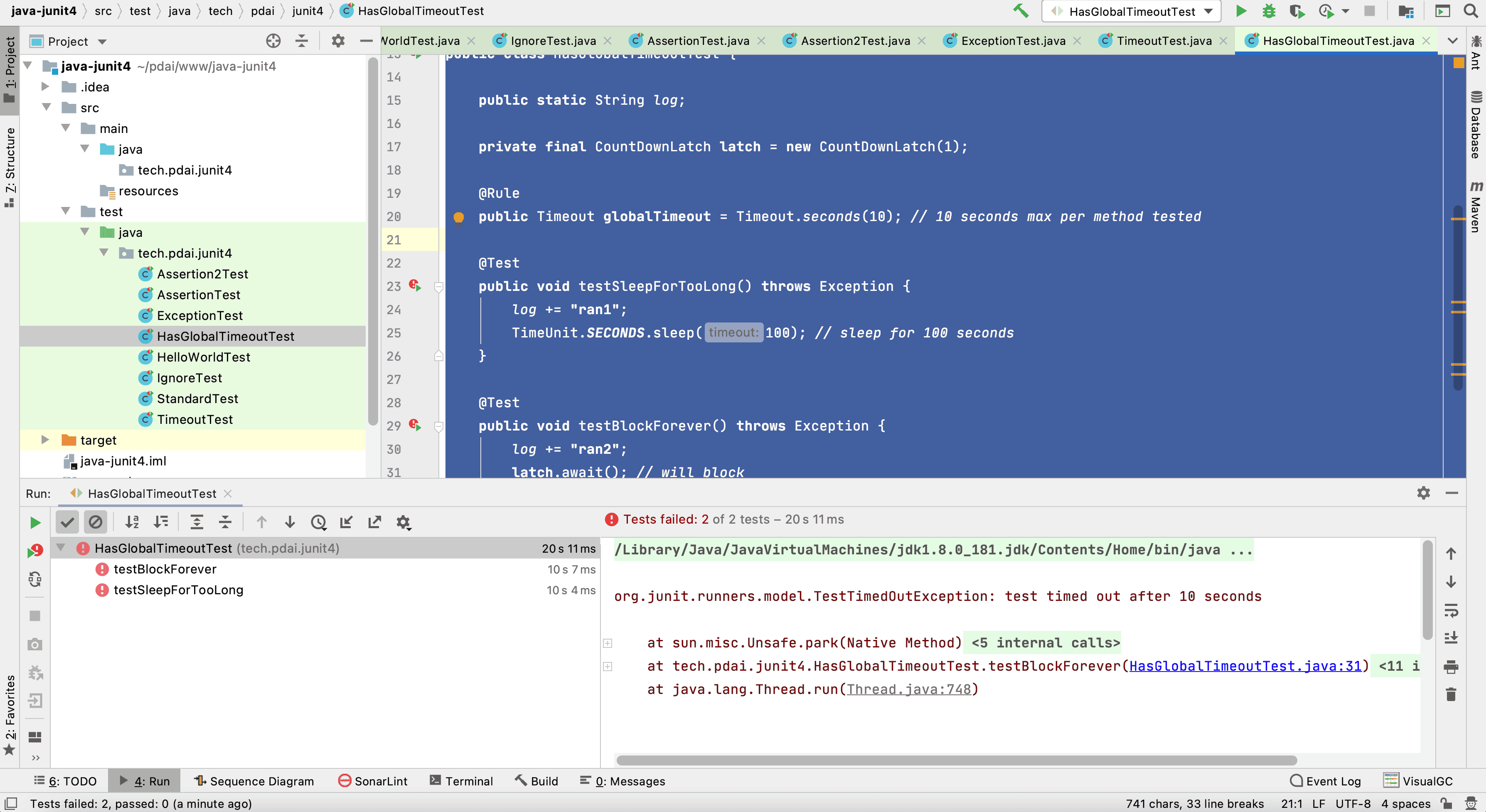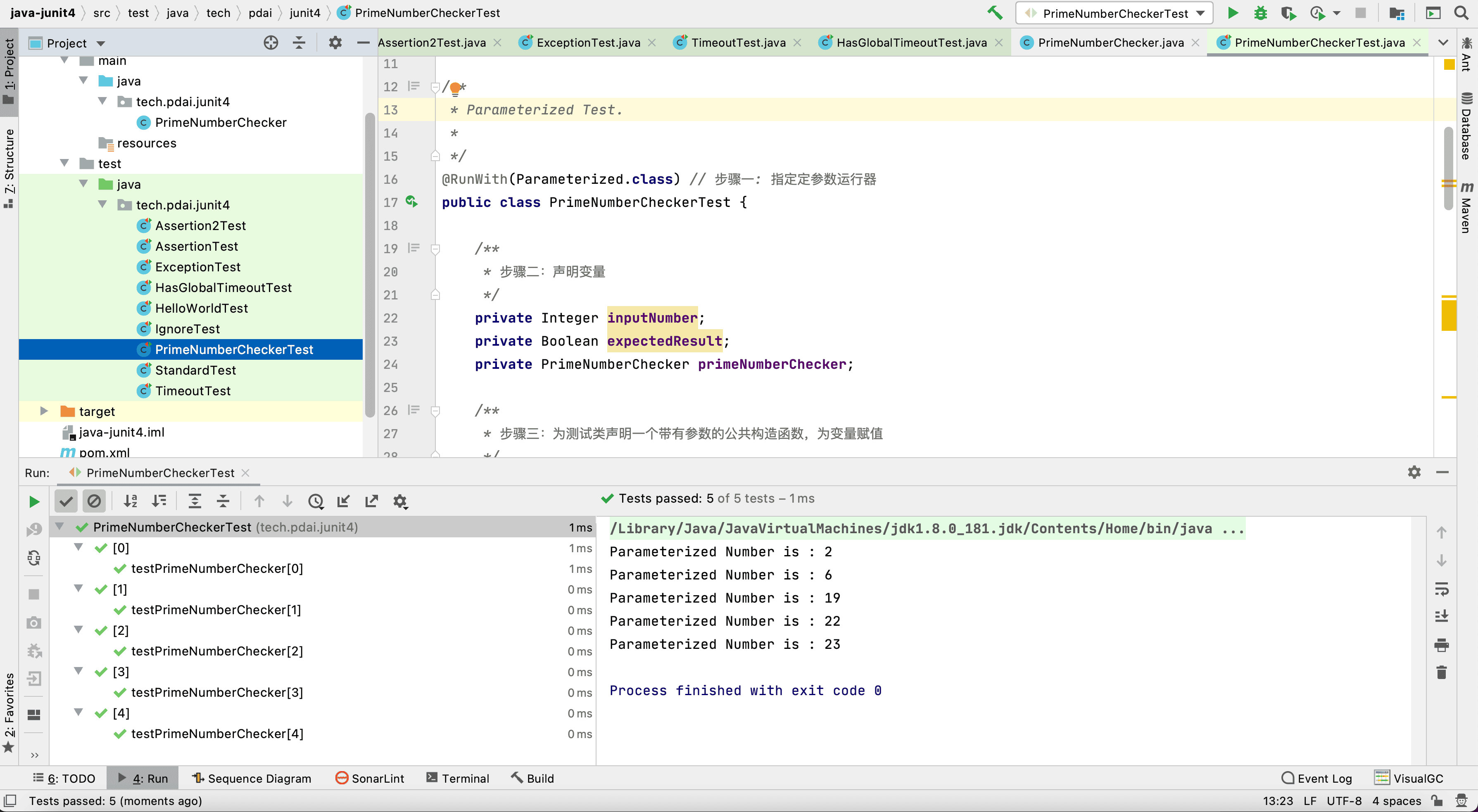JUnit4 详解
JUnit4 详解
JUint是Java编程语言的单元测试框架,用于编写和运行可重复的自动化测试。本文主要针对Junit4要点进行梳理总结。
什么是JUnit?
JUint是Java编程语言的单元测试框架,用于编写和运行可重复的自动化测试。
JUnit特点?
JUnit 是一个开放的资源框架,用于编写和运行测试。
- 提供注解来识别测试方法。
- 提供断言来测试预期结果。
- JUnit 测试允许你编写代码更快,并能提高质量。
- JUnit 优雅简洁。没那么复杂,花费时间较少。
- JUnit测试可以自动运行并且检查自身结果并提供即时反馈。所以也没有必要人工梳理测试结果的报告。
- JUnit测试可以被组织为测试套件,包含测试用例,甚至其他的测试套件。
- JUnit在一个条中显示进度。如果运行良好则是绿色;如果运行失败,则变成红色。
官方资料
最好的资料依然在Junit官方网站,以下我帮你总结下Junit相关的官方网址。
- 官网地址
- 官方入门文档
https://github.com/junit-team/junit4/wiki/Assertions
- 官方github
常用注解
- @Test
在junit3中,是通过对测试类和测试方法的命名来确定是否是测试,且所有的测试类必须继承junit的测试基类。在junit4中,定义一个测试方法变得简单很多,只需要在方法前加上@Test就行了。
注意:测试方法必须是public void,即公共、无返回数据。可以抛出异常。
- @Ignore
有时候我们想暂时不运行某些测试方法\测试类,可以在方法前加上这个注解。在运行结果中,junit会统计忽略的用例数,来提醒你。但是不建议经常这么做,因为这样的坏处时,容易忘记去更新这些测试方法,导致代码不够干净,用例遗漏。使用此标注的时候不能与其它标注一起使用,如:和@Test 标注一起使用,那就没用了
- @BeforeClass
当我们运行几个有关联的用例时,可能会在数据准备或其它前期准备中执行一些相同的命令,这个时候为了让代码更清晰,更少冗余,可以将公用的部分提取出来,放在一个方法里,并为这个方法注解@BeforeClass。意思是在测试类里所有用例运行之前,运行一次这个方法。例如创建数据库连接、读取文件等。
注意:方法名可以任意,但必须是public static void,即公开、静态、无返回。这个方法只会运行一次。
- @AfterClass
跟@BeforeClass对应,在测试类里所有用例运行之后,运行一次。用于处理一些测试后续工作,例如清理数据,恢复现场。
注意:同样必须是public static void,即公开、静态、无返回。这个方法只会运行一次。
- @Before
与@BeforeClass的区别在于,@Before不止运行一次,它会在每个用例运行之前都运行一次。主要用于一些独立于用例之间的准备工作。
比如两个用例都需要读取数据库里的用户A信息,但第一个用例会删除这个用户A,而第二个用例需要修改用户A。那么可以用@BeforeClass创建数据库连接。用@Before来插入一条用户A信息。
注意:必须是public void,不能为static。不止运行一次,根据用例数而定。
- @After:与@Before对应。
- @Runwith
- 首先要分清几个概念:测试方法、测试类、测试集、测试运行器。
- 其中测试方法就是用@Test注解的一些函数。
- 测试类是包含一个或多个测试方法的一个Test.java文件。
- 测试集是一个suite,可能包含多个测试类。
- 测试运行器则决定了用什么方式偏好去运行这些测试集/类/方法。
- 而@Runwith就是放在测试类名之前,用来确定这个类怎么运行的。也可以不标注,会使用默认运行器。常见的运行器有:
- @RunWith(Parameterized.class) 参数化运行器,配合@Parameters使用junit的参数化功能
- @RunWith(Suite.class) @SuiteClasses({ATest.class,BTest.class,CTest.class})测试集运行器配合使用测试集功能
- @RunWith(JUnit4.class) junit4的默认运行器
- @RunWith(JUnit38ClassRunner.class) 用于兼容junit3.8的运行器
- 一些其它运行器具备更多功能。例如@RunWith(SpringJUnit4ClassRunner.class)集成了spring的一些功能
- @Parameters: 用于使用参数化功能。
编写单元测试
接下来,我们开始学习JUnit4单元测试实例:
Maven包引入
<?xml version="1.0" encoding="UTF-8"?>
<project xmlns="http://maven.apache.org/POM/4.0.0"
xmlns:xsi="http://www.w3.org/2001/XMLSchema-instance"
xsi:schemaLocation="http://maven.apache.org/POM/4.0.0 http://maven.apache.org/xsd/maven-4.0.0.xsd">
<modelVersion>4.0.0</modelVersion>
<groupId>org.example</groupId>
<artifactId>java-junit4</artifactId>
<version>1.0-SNAPSHOT</version>
<build>
<plugins>
<plugin>
<groupId>org.apache.maven.plugins</groupId>
<artifactId>maven-compiler-plugin</artifactId>
<configuration>
<source>8</source>
<target>8</target>
</configuration>
</plugin>
</plugins>
</build>
<dependencies>
<dependency>
<groupId>junit</groupId>
<artifactId>junit</artifactId>
<version>4.12</version>
<scope>test</scope>
</dependency>
</dependencies>
</project>
测试:Hello World
package com.gavin.james.junit4;
import org.junit.Test;
import static org.junit.Assert.assertEquals;
/**
* Hello world test.
*
* @author pdai
*/
public class HelloWorldTest {
@Test
public void firstTest() {
assertEquals(2, 1 + 1);
}
}
执行结果

@Test注解在方法上标记方法为测试方法,以便构建工具和 IDE 能够识别并执行它们。JUnit 4 需要测试方法为public,这和Junit 5 有差别。
测试:生命周期
- @BeforeClass注解修饰的方法(该方法要用static修饰)会在所有方法运行前被执行,且只执行一次,通常用来为后面测试方法的准备工作,如加载配置、进行数据库的连接等。父类的@BeforeClass注解方法会在子类的@BeforeClass注解方法执行前执行。
- @Before注解修饰的方法会在每个测试方法执行前执行一次,父类@Before修饰的方法会在子类@Before修饰的方法执行前 执行
- @After注解修饰的方法会在每个测试方法执行后执行一次,父类@After修饰的方法会在子类@After修饰的方法执行后执行。
- @AfterClass注解修饰的方法(该方法要用static修饰)会在所有方法执行结束后执行一次,且也只执行一次,通常用来对资源进行释放,比如数据库连接的关闭等,无论测试用例里的其他方法有没有抛出异常,该方法最终都会被执行。而且父类中的被@AfterClass注解方法修饰的方法会在子类的@AfterClass注解修饰的方法执行之后才会被执行。
package com.gavin.james.junit4;
import org.junit.*;
/**
* Standard Test.
*/
public class StandardTest {
@BeforeClass
public static void beforeClass() {
System.out.println("in before class");
}
@AfterClass
public static void afterClass() {
System.out.println("in after class");
}
@Before
public void before() {
System.out.println("in before");
}
@After
public void after() {
System.out.println("in after");
}
@Test
public void testCase1() {
System.out.println("in test case 1");
}
@Test
public void testCase2() {
System.out.println("in test case 2");
}
}
执行结果

测试:禁用测试
@Ignore:暂不执行该方法;
package com.gavin.james.junit4;
import org.junit.Ignore;
import org.junit.Test;
/**
* Ignore Test.
*/
public class IgnoreTest {
/**
* ignore.
*/
@Ignore
@Test
public void ignoreTest(){
System.out.println("ignore test");
}
}
执行结果

测试:断言测试
- 断言测试注解有哪些
| 断言 | 描述 |
|---|---|
| void assertEquals([String message],expected value,actual value) | 断言两个值相等。值类型可能是int,short,long,byte,char,Object,第一个参数是一个可选字符串消息 |
| void assertTrue([String message],boolean condition) | 断言一个条件为真 |
| void assertFalse([String message],boolean condition) | 断言一个条件为假 |
| void assertNotNull([String message],java.lang.Object object) | 断言一个对象不为空(null) |
| void assertNull([String message],java.lang.Object object) | 断言一个对象为空(null) |
| void assertSame([String message],java.lang.Object expected,java.lang.Object actual) | 断言两个对象引用相同的对象 |
| void assertNotSame([String message],java.lang.Object unexpected,java.lang.Object actual) | 断言两个对象不是引用同一个对象 |
| void assertArrayEquals([String message],expectedArray,resultArray) | 断言预期数组和结果数组相等,数组类型可能是int,short,long,byte,char,Object |
- 简单测试
package com.gavin.james.junit4;
import org.junit.Assert;
import org.junit.Test;
/**
* Assertion Test.
*/
public class AssertionTest {
@Test
public void test() {
String obj1 = "junit";
String obj2 = "junit";
String obj3 = "test";
String obj4 = "test";
String obj5 = null;
int var1 = 1;
int var2 = 2;
int[] array1 = {1, 2, 3};
int[] array2 = {1, 2, 3};
Assert.assertEquals(obj1, obj2);
Assert.assertSame(obj3, obj4);
Assert.assertNotSame(obj2, obj4);
Assert.assertNotNull(obj1);
Assert.assertNull(obj5);
Assert.assertTrue(var1 < var2);
Assert.assertFalse(var1 > var2);
Assert.assertArrayEquals(array1, array2);
}
}
在以上类中我们可以看到,这些断言方法是可以工作的。
- assertEquals() 如果比较的两个对象是相等的,此方法将正常返回;否则失败显示在JUnit的窗口测试将中止。
- assertSame() 和 assertNotSame() 方法测试两个对象引用指向完全相同的对象。
- assertNull() 和 assertNotNull() 方法测试一个变量是否为空或不为空(null)。
- assertTrue() 和 assertFalse() 方法测试if条件或变量是true还是false。
- assertArrayEquals() 将比较两个数组,如果它们相等,则该方法将继续进行不会发出错误。否则失败将显示在JUnit窗口和中止测试。
- 更多测试,来自官网https://github.com/junit-team/junit4/wiki/Assertions
package com.gavin.james.junit4;
import org.hamcrest.core.CombinableMatcher;
import org.junit.Test;
import java.util.Arrays;
import static org.hamcrest.CoreMatchers.*;
import static org.junit.Assert.*;
/**
* More Assertion Test from Junit-Team.
*/
public class Assertion2Test {
@Test
public void testAssertArrayEquals() {
byte[] expected = "trial".getBytes();
byte[] actual = "trial".getBytes();
assertArrayEquals("failure - byte arrays not same", expected, actual);
}
@Test
public void testAssertEquals() {
assertEquals("failure - strings are not equal", "text", "text");
}
@Test
public void testAssertFalse() {
assertFalse("failure - should be false", false);
}
@Test
public void testAssertNotNull() {
assertNotNull("should not be null", new Object());
}
@Test
public void testAssertNotSame() {
assertNotSame("should not be same Object", new Object(), new Object());
}
@Test
public void testAssertNull() {
assertNull("should be null", null);
}
@Test
public void testAssertSame() {
Integer aNumber = Integer.valueOf(768);
assertSame("should be same", aNumber, aNumber);
}
// JUnit Matchers assertThat
@Test
public void testAssertThatBothContainsString() {
assertThat("albumen", both(containsString("a")).and(containsString("b")));
}
@Test
public void testAssertThatHasItems() {
assertThat(Arrays.asList("one", "two", "three"), hasItems("one", "three"));
}
@Test
public void testAssertThatEveryItemContainsString() {
assertThat(Arrays.asList(new String[]{"fun", "ban", "net"}), everyItem(containsString("n")));
}
// Core Hamcrest Matchers with assertThat
@Test
public void testAssertThatHamcrestCoreMatchers() {
assertThat("good", allOf(equalTo("good"), startsWith("good")));
assertThat("good", not(allOf(equalTo("bad"), equalTo("good"))));
assertThat("good", anyOf(equalTo("bad"), equalTo("good")));
assertThat(7, not(CombinableMatcher.<Integer>either(equalTo(3)).or(equalTo(4))));
assertThat(new Object(), not(sameInstance(new Object())));
}
@Test
public void testAssertTrue() {
assertTrue("failure - should be true", true);
}
}
执行结果

测试:异常测试
Junit 用代码处理提供了一个追踪异常的选项。你可以测试代码是否它抛出了想要得到的异常。expected 参数和 @Test 注释一起使用。现在让我们看看 @Test(expected):
package com.gavin.james.junit4;
import org.junit.Test;
/**
* Exception Test.
*/
public class ExceptionTest {
@Test(expected = ArithmeticException.class)
public void exceptionTest() {
System.out.println("in exception success test");
int a = 0;
int b = 1 / a;
}
@Test(expected = NullPointerException.class)
public void exceptionFailTest() {
System.out.println("in exception fail test");
int a = 0;
int b = 1 / a;
}
}
执行结果

观察错误的信息:
in exception success test
in exception fail test
java.lang.Exception: Unexpected exception, expected<java.lang.NullPointerException> but was<java.lang.ArithmeticException>
at org.junit.internal.runners.statements.ExpectException.evaluate(ExpectException.java:28)
at org.junit.runners.ParentRunner.runLeaf(ParentRunner.java:325)
at org.junit.runners.BlockJUnit4ClassRunner.runChild(BlockJUnit4ClassRunner.java:78)
at org.junit.runners.BlockJUnit4ClassRunner.runChild(BlockJUnit4ClassRunner.java:57)
at org.junit.runners.ParentRunner$3.run(ParentRunner.java:290)
at org.junit.runners.ParentRunner$1.schedule(ParentRunner.java:71)
at org.junit.runners.ParentRunner.runChildren(ParentRunner.java:288)
at org.junit.runners.ParentRunner.access$000(ParentRunner.java:58)
at org.junit.runners.ParentRunner$2.evaluate(ParentRunner.java:268)
at org.junit.runners.ParentRunner.run(ParentRunner.java:363)
at org.junit.runner.JUnitCore.run(JUnitCore.java:137)
at com.intellij.junit4.JUnit4IdeaTestRunner.startRunnerWithArgs(JUnit4IdeaTestRunner.java:68)
at com.intellij.rt.junit.IdeaTestRunner$Repeater.startRunnerWithArgs(IdeaTestRunner.java:33)
at com.intellij.rt.junit.JUnitStarter.prepareStreamsAndStart(JUnitStarter.java:230)
at com.intellij.rt.junit.JUnitStarter.main(JUnitStarter.java:58)
Caused by: java.lang.ArithmeticException: / by zero
at com.gavin.james.junit4.ExceptionTest.exceptionFailTest(ExceptionTest.java:21)
at sun.reflect.NativeMethodAccessorImpl.invoke0(Native Method)
at sun.reflect.NativeMethodAccessorImpl.invoke(NativeMethodAccessorImpl.java:62)
at sun.reflect.DelegatingMethodAccessorImpl.invoke(DelegatingMethodAccessorImpl.java:43)
at java.lang.reflect.Method.invoke(Method.java:498)
at org.junit.runners.model.FrameworkMethod$1.runReflectiveCall(FrameworkMethod.java:50)
at org.junit.internal.runners.model.ReflectiveCallable.run(ReflectiveCallable.java:12)
at org.junit.runners.model.FrameworkMethod.invokeExplosively(FrameworkMethod.java:47)
at org.junit.internal.runners.statements.InvokeMethod.evaluate(InvokeMethod.java:17)
at org.junit.internal.runners.statements.ExpectException.evaluate(ExpectException.java:19)
... 14 more
测试:时间测试
JUnit提供了一个暂停的方便选项,如果一个测试用例比起指定的毫秒数花费了更多的时间,那么JUnit将自动将它标记为失败,timeout参数和@Test注解一起使用,例如@Test(timeout=1000)。
- 简单例子
package com.gavin.james.junit4;
import org.junit.Test;
import java.util.concurrent.TimeUnit;
/**
* Timeout Test.
*/
public class TimeoutTest {
@Test(timeout = 1000)
public void testCase1() throws InterruptedException {
TimeUnit.SECONDS.sleep(5000);
System.out.println("in timeout exception");
}
}
执行结果

观察错误的信息:
org.junit.runners.model.TestTimedOutException: test timed out after 1000 milliseconds
at java.lang.Thread.sleep(Native Method)
at java.lang.Thread.sleep(Thread.java:340)
at java.util.concurrent.TimeUnit.sleep(TimeUnit.java:386)
at com.gavin.james.junit4.TimeoutTest.testCase1(TimeoutTest.java:14)
at sun.reflect.NativeMethodAccessorImpl.invoke0(Native Method)
at sun.reflect.NativeMethodAccessorImpl.invoke(NativeMethodAccessorImpl.java:62)
at sun.reflect.DelegatingMethodAccessorImpl.invoke(DelegatingMethodAccessorImpl.java:43)
at java.lang.reflect.Method.invoke(Method.java:498)
at org.junit.runners.model.FrameworkMethod$1.runReflectiveCall(FrameworkMethod.java:50)
at org.junit.internal.runners.model.ReflectiveCallable.run(ReflectiveCallable.java:12)
at org.junit.runners.model.FrameworkMethod.invokeExplosively(FrameworkMethod.java:47)
at org.junit.internal.runners.statements.InvokeMethod.evaluate(InvokeMethod.java:17)
at org.junit.internal.runners.statements.FailOnTimeout$CallableStatement.call(FailOnTimeout.java:298)
at org.junit.internal.runners.statements.FailOnTimeout$CallableStatement.call(FailOnTimeout.java:292)
at java.util.concurrent.FutureTask.run(FutureTask.java:266)
at java.lang.Thread.run(Thread.java:748)
- 超时规则
应用到测试类的所有测试用例
package com.gavin.james.junit4;
import org.junit.Rule;
import org.junit.Test;
import org.junit.rules.Timeout;
import java.util.concurrent.CountDownLatch;
import java.util.concurrent.TimeUnit;
/**
* Timeout Rule.
*/
public class HasGlobalTimeoutTest {
public static String log;
private final CountDownLatch latch = new CountDownLatch(1);
@Rule
public Timeout globalTimeout = Timeout.seconds(10); // 10 seconds max per method tested
@Test
public void testSleepForTooLong() throws Exception {
log += "ran1";
TimeUnit.SECONDS.sleep(100); // sleep for 100 seconds
}
@Test
public void testBlockForever() throws Exception {
log += "ran2";
latch.await(); // will block
}
}
执行结果

测试:参数化测试
Junit 4 引入了一个新的功能参数化测试。参数化测试允许开发人员使用不同的值反复运行同 一个测试。你将遵循 5 个步骤来创建参数化测试:
- 为准备使用参数化测试的测试类指定特殊的运行器 org.junit.runners.Parameterized。
- 为测试类声明几个变量,分别用于存放期望值和测试所用数据。
- 为测试类声明一个带有参数的公共构造函数,并在其中为第二个环节中声明的几个变量赋值。
- 为测试类声明一个使用注解 org.junit.runners.Parameterized.Parameters 修饰的,返回值为 java.util.Collection 的公共静态方法,并在此方法中初始化所有需要测试的参数对。
- 编写测试方法,使用定义的变量作为参数进行测试。
什么是@RunWith?
首先要分清几个概念:测试方法、测试类、测试集、测试运行器。
- 其中测试方法就是用@Test注解的一些函数。
- 测试类是包含一个或多个测试方法的一个**Test.java文件,
- 测试集是一个suite,可能包含多个测试类。
- 测试运行器则决定了用什么方式偏好去运行这些测试集/类/方法。
而@Runwith就是放在测试类名之前,用来确定这个类怎么运行的。也可以不标注,会使用默认运行器。常见的运行器有:
- @RunWith(Parameterized.class) 参数化运行器,配合@Parameters使用JUnit的参数化功能
- @RunWith(Suite.class) @SuiteClasses({ATest.class,BTest.class,CTest.class}) 测试集运行器配合使用测试集功能
- @RunWith(JUnit4.class), junit4的默认运行器
- @RunWith(JUnit38ClassRunner.class),用于兼容junit3.8的运行器 一些其它运行器具备更多功能。例如@RunWith(SpringJUnit4ClassRunner.class)集成了spring的一些功能
- 测试例子
待测试类
package com.gavin.james.junit4;
/**
* PrimeNumberChecker.
*/
public class PrimeNumberChecker {
public Boolean validate(final Integer parimeNumber) {
for (int i = 2; i < (parimeNumber / 2); i++) {
if (parimeNumber % i == 0) {
return false;
}
}
return true;
}
}
测试类
package com.gavin.james.junit4;
import org.junit.Assert;
import org.junit.Before;
import org.junit.Test;
import org.junit.runner.RunWith;
import org.junit.runners.Parameterized;
import java.util.Arrays;
import java.util.Collection;
/**
* Parameterized Test.
*
*/
@RunWith(Parameterized.class) // 步骤一: 指定定参数运行器
public class PrimeNumberCheckerTest {
/**
* 步骤二:声明变量
*/
private Integer inputNumber;
private Boolean expectedResult;
private PrimeNumberChecker primeNumberChecker;
/**
* 步骤三:为测试类声明一个带有参数的公共构造函数,为变量赋值
*/
public PrimeNumberCheckerTest(Integer inputNumber,
Boolean expectedResult) {
this.inputNumber = inputNumber;
this.expectedResult = expectedResult;
}
/**
* 步骤四:为测试类声明一个使用注解 org.junit.runners.Parameterized.Parameters 修饰的,返回值为
* java.util.Collection 的公共静态方法,并在此方法中初始化所有需要测试的参数对
* 1)该方法必须由Parameters注解修饰
2)该方法必须为public static的
3)该方法必须返回Collection类型
4)该方法的名字不做要求
5)该方法没有参数
*/
@Parameterized.Parameters
public static Collection primeNumbers() {
return Arrays.asList(new Object[][]{
{2, true},
{6, false},
{19, true},
{22, false},
{23, true}
});
}
@Before
public void initialize() {
primeNumberChecker = new PrimeNumberChecker();
}
/**
* 步骤五:编写测试方法,使用自定义变量进行测试
*/
@Test
public void testPrimeNumberChecker() {
System.out.println("Parameterized Number is : " + inputNumber);
Assert.assertEquals(expectedResult,
primeNumberChecker.validate(inputNumber));
}
}
执行结果

测试:套件测试
“套件测试”是指捆绑了几个单元测试用例并运行起来。在JUnit中,@RunWith 和 @Suite 这两个注解是用来运行套件测试。先来创建几个测试类
测试类1
package com.gavin.james.junit4.testsuite;
import org.junit.Test;
public class JunitTest1 {
@Test
public void printMessage(){
System.out.println("in JunitTest1");
}
}
测试类2
package com.gavin.james.junit4.testsuite;
import org.junit.Test;
public class JunitTest2 {
@Test
public void printMessage(){
System.out.println("in JunitTest2");
}
}
测试套件
package com.gavin.james.junit4.testsuite;
import org.junit.runner.RunWith;
import org.junit.runners.Suite;
/**
* Test suite.
*/
@RunWith(Suite.class)
@Suite.SuiteClasses({
/**
* 此处类的配置顺序会影响执行顺序
*/
JunitTest1.class,
JunitTest2.class
})
public class JunitSuiteTest {
}
执行结果

测试:测试顺序
自定义测试方法的顺序,比如按照方法的名字顺序:
package com.gavin.james.junit4;
import org.junit.FixMethodOrder;
import org.junit.Test;
import org.junit.runners.MethodSorters;
/**
* Order.
*/
@FixMethodOrder(MethodSorters.NAME_ASCENDING)
public class TestMethodOrder {
@Test
public void testA() {
System.out.println("first");
}
@Test
public void testC() {
System.out.println("third");
}
@Test
public void testB() {
System.out.println("second");
}
}
执行结果
